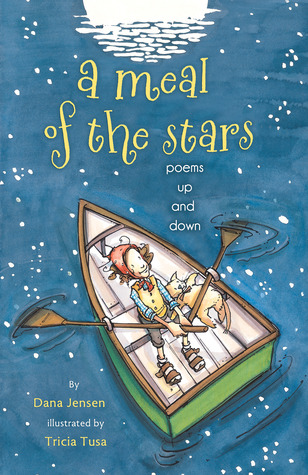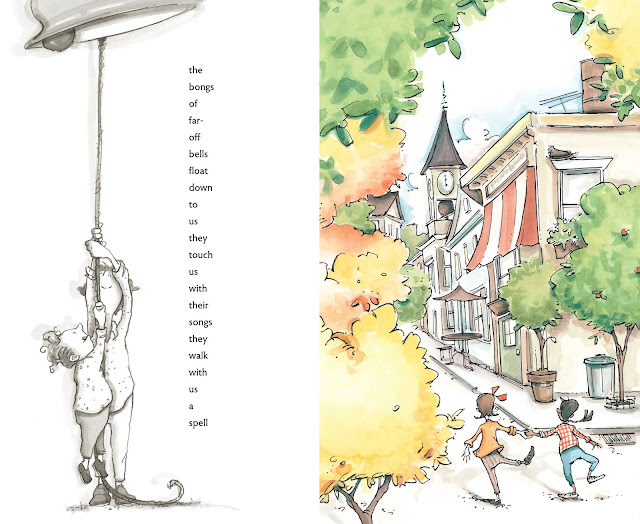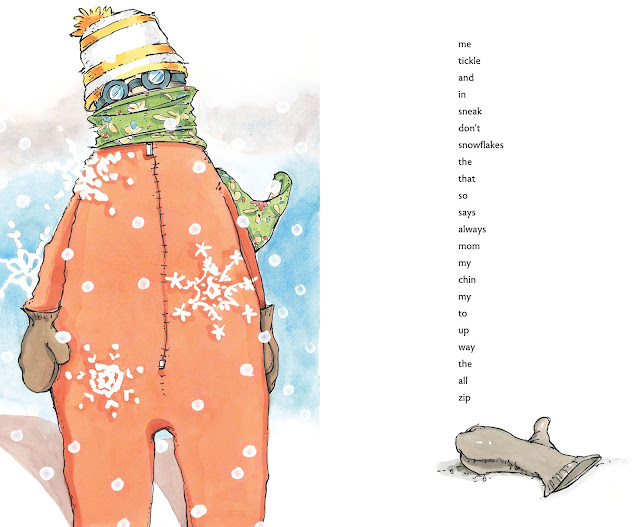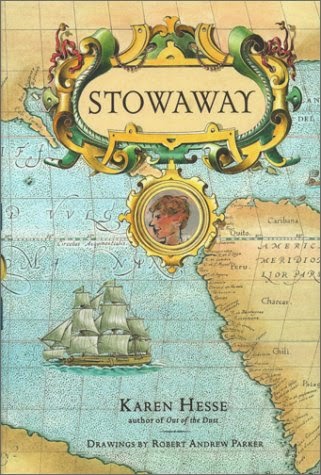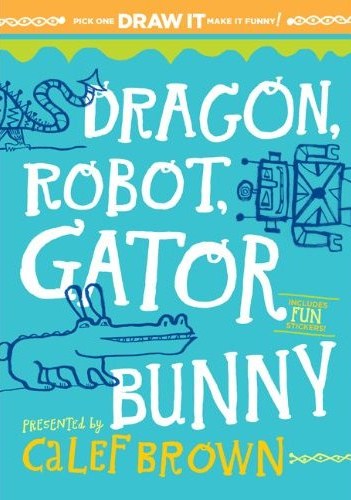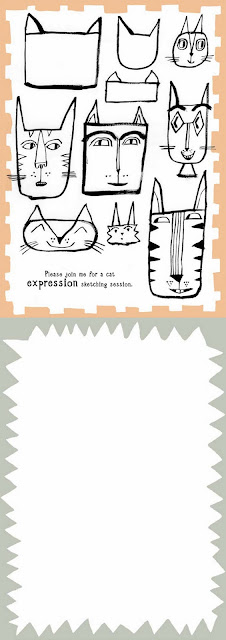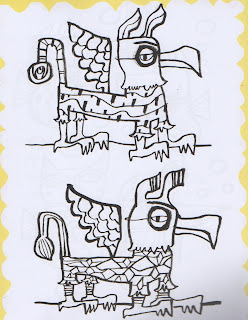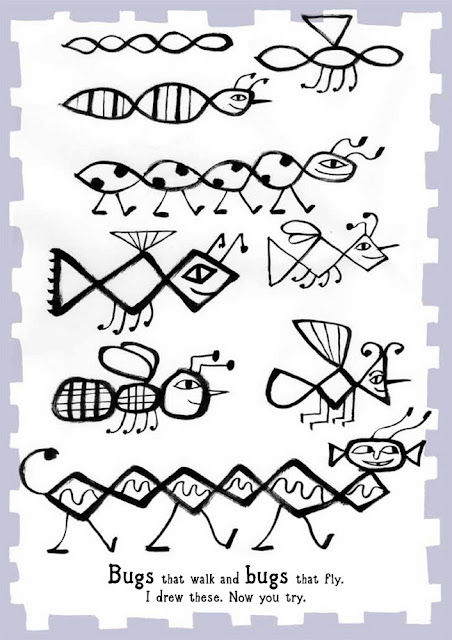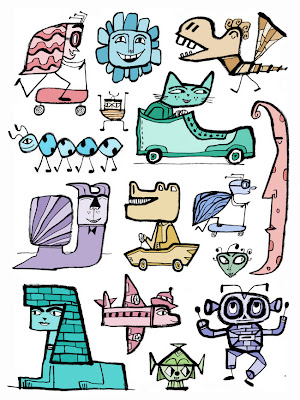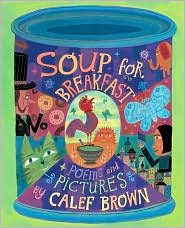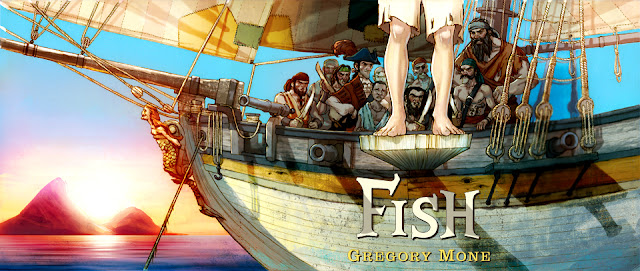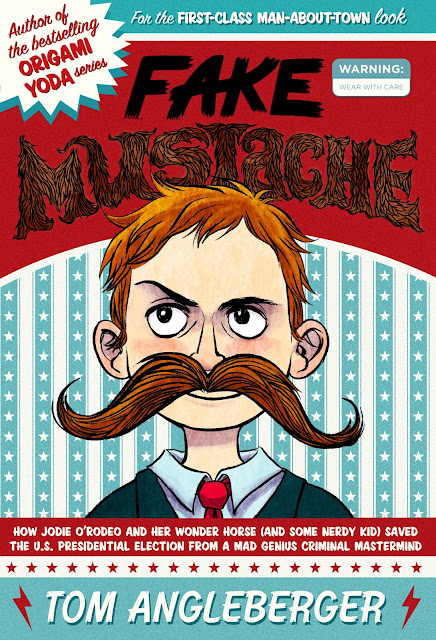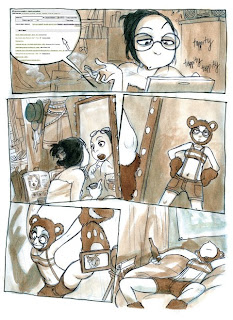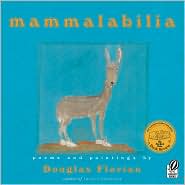a meal of the stars : poems up and down by Dana Jensen with illustrations by Tricia Tusa is a unique book of poems. I am a huge fan of Tricia Tusa's art work and you can read a fantastic interview (from 2008) with her and see some of her work as well as her studio by visiting Seven Impossible Things Before Breakfast. Tusa's delightful illustrations add so much to the Jensen's playful poems, which are very visual themselves. As you might have guessed from the title, these untitled poems are meant to be read from the bottom up sometimes and from the top down others. Waterfalls, kites, ladders, elevators, giraffes, ferris wheels and balloons on strings are the subject matter here. They speak best for themselves, so enjoy these spreads from this wonderful book. These creative, fun poems will surely inspire readers to write and illustrate some up and down poems of their own!
Where you can find the best book at the right reading level and spark (or fuel) a life long love of reading in your kids!
4.28.2012
4.27.2012
Stowaway, by Karen Hesse with illustrations by Robert Andrew Parker, 315 pp, RL 4
I suppose one of the perks of knowing almost nothing about history is that I can go into reading a work of historical fiction for young readers with almost the exact same collection of knowledge as the intended audience has, which basically means no preconceived notions and, more often than not, no real idea of how the book will end. I guess I do have the advantage (over kids) of knowing that a book I am about to read is based on real historical figures, places and events and being able to place their achievements and losses in historical perspective, despite my shoddy knowledge of the history of the world. And, while I did know that Captain Cook and his ship Endeavor were real, I had no idea where he sailed to and what the significance of his voyage was. With this in mind, I might suggest that readers begin Stowaway by the always amazing Karen Hesse, at the end of the book. The Afterword will provide readers with a solid grasp of the time, place and people in the story and the factual lists, glossary and map will help readers begin to gain an understanding of the alien world of life on a ship near the end of the Eighteenth Century that they are about the enter. Hesse brings her way with history to this adventure story, the imagine diary of the very real Nicholas Young, who is eleven when he buys his way aboard the Endeavor as a stowaway. Not only was this stowaway the first to sight New Zealand (Young Nick's Head, a prominent point on the island) is named for him, he was also the first to sight Land's End, the home port of Plymouth, almost three years after he stowed away aboard Captain Cook's Endeavor.
Besides a map charting the voyage, Hesse provides a list of the ship's company and their ages, when available, the ship's itinerary and a glossary of terms, which I found invaluable and enjoyed immensely. The episodic diary nature of Stowaway is well suited to the story of the thirty-five month long ocean journey as it is at times exciting and suspenseful and alternately placid and occasionally dull. Hesse sails along with this up and down pace and holds the reader's interest by giving life to Nick Young. In Nick, Hesse imagines a young boy who has seen enough hardship to drive him to steal from his master and stow away on a ship, but also one who comes from an educated class that values subservience in their young as well a solid education. When, after his mother's death and his father's remarriage, Nick proves to be less willing to tow the line than his older brothers who are at university, his father takes action. Sent first to be educated by the Reverend Smythe who beats his own children because he cannot beat his paying pupils (not only does he beat his children, he forces the ill-behaved student to watch) this is more than Nick can bear. When he runs away from Reverend Smythe one too many times Nick's father sends him to apprentice a butcher in Plymouth, who has no qualms about beating him to the point of scarring. Nick's miserable situation and a view of the ships in the bay combine to make the dangers of theft and stowing away seem like the best option out there.
In Nick Hesse creates a thoughtful, curious, principaled boy who grows into a promising, motivated young man over the course of the three years he is at sea. Fortuitously, Nick brings a journal and writing implement with him as he is hidden in the Pinnace, a small bark on the Endeavor, for eighteen days. He does a fine job of describing the increasingly rank smell that emanates off him as he goes unwashed and underfed for almost three weeks while Samuel Evans, Francis Hattie and John Ramsay, the seamen who smuggled Nick aboard for three coins, tend to him when they can. His descriptive skills and curiosity about the new world around him - from the ship to the seas to the foreign lands they visit - make Nick an observant diarist. Once he comes forward and presents himself to Captain Cook, who agrees to make him a mate, Nick is able to describe life on the ship, of which he plays a varied part. From teaching Samuel Evans, the Quartermaster and coxswain of the Pinnace, to read, and charting the course of the Endeavor with the help of John Charlton, the captain's servant, to comforting the lone goat on board as well as the naturalist Mr Banks's greyhounds, Lord and Lady Grey. Nick also finds himself occasional assistant to the supernumeraries, the naturalist, the astronomer, the artist and eventually their Polynesian guide Tupia and his young servant, Tarheto, who becomes Nick's best friend. And, in times of illness, Nick is at the side of Dr William Monkhouse, the surgeon on board, who spends much of his time battling scurvy and, near the end of their voyage, a merciless epidemic of dysentery. While the crew knows that they are on a mission to take astronomical readings somewhere in the Southern Hemisphere, they do not know until they are well underway that they are also on a mission to secretly search for a new continent on the King's Orders.
The subtleties of the voyage of Endeavor might be lost on younger readers or those who do not have a preexisting interest in historical sea voyages. Most of the book is taken up with describing life on the ship, the activities and actions of the men on board and the ways in which they work together and against each other at times. Mr Bootie, a midshipman, takes an immediate dislike to Nick and makes his life painful whenever he can. At times reading about life on board is can be almost as dull as being stuck in a doldrum and waiting for a wind. This is an important part of the book and Hesse conveys this quietude well. However, before the reader is tempted to give up on the book she makes sure to carry the story along on a new wave of action or interest. The Endeavor visits many native peoples on their visits to Tahiti, New Zealand and Australia, which they call New Holland. The descriptions of these encounters, not all of which are friendly, are fascinating as are the ways in which the Captain negotiates and trades with the natives, some of whom try to swindle and even steal from him. And there are cannibals. An internet search of images from the times and places that Nick describes would defintitely enhance the reader's enjoyment of this book at this point.
The final third of the book is hard to put down - from an almost deadly encounter with the Great Barrier Reef to a truly deadly encounter with dysentery when the ship finally makes it to the Dutch colony of Batavia, Jakarta. Many of the crew, from the lowest to almost the highest ranking sailors, succumb to this horrible disease while waiting for the ship to be repaired so that they can make the six month long journey back to England. As an adult reader, what sustained me throughout was the personality and humanity of Nick Young himself, which is where Hesse's skill as a writer really shines. Almost a year from home, but headed in that direction, Nick and his mates begin to feel a sense of melancholy. Dr Monkhouse tells him that they are all "suffering from a disease called Nostalgia." But Nick wonders how "Tupia and Tarheto must feel? When shall they see their home again?" Nick's empathy is also evident when, two months from home, Lieutenant Hicks dies from a case of consumption that he has had since sailing from England. Nick writes, "He might have survived, though, at least to see home, if it had not been for Batavia. Father apprenticed me to the Butcher to cure me of my soft heart. Surely, with all that I have seen, my heart should be stone by now. And yet I hurt." And, finally, although there is not much room or time on board for the crew to have personal interests and pursuits, Nick brings with him a fascination with birds and a gift for bird calls that he developed shortly after his mother died. At times, his calls and the birds' responses offer cheer to the crew. At other times, solace to Nick alone. On Thursday, September 27th, 1770 Nick writes, "Wind fresh again and bird everywhere in the sky. They cried above us and I cried back to them. Closing my eyes, I felt the shadow of their wings upon my face." And with that, Hesse imbues Nick with a bit of her poetic gifts.
Without a doubt, Karen Hesse's Stowaway is a phenomenal book, both a gripping read and excellent teaching tool. That said, I think that this is also a book that requires a bit of background knowledge in geography and history to make the reading experience that much more valuable. This is a great book for parents and kids to read simultaneously, with parents providing supplemental information and occasional explanations. However, I fear that Stowaway might also be the kind of book that most readers turn their noses up at precisely for these reasons.
4.25.2012
Dragon, Robot, Gatorbunny, presented by Calef Brown, all ages
Calef Brown, poet, painter and all around funky creator, is now a doodle book maker! I didn't intend for that sentence to be so rhyme-y, but Brown and his new book, Dragon, Robot, Gatorbunny, just inspire that kind of playfulness. For an overview of Brown's work, click here and for a sampling of his poetry, click on poem titles: Snails and Skeleton Flowers. For details on Dragon, Robot, Gatorbunny, read on!
The introduction to Dragon, Robot, Gatorbunny begins, "Hello! Hello! Calef Brown here. May I tell you something? I love to draw! It's my favorites thing to do, anytime, anywhere. I sketch and doodle with pens, pencils, markers and brushes. I usually start with an outline, or a simple shape - a circle, a triangle, maybe a funky trapezoid. Then it's time for lots of lines - thing lines, thick lines, zigzags, loops. Eyes and noses. Ears and mouths, wings and paws. Whiskers. Fins. Wheels?" He goes on to encourage artists to "jump right in! Follow some of my drawings, if you'd like, combine them, or feel free to make up your own fantastical creations!" Brown starts his book with snails because, as he says on his website, "The book begins with what inspired it - the drawings of snails that I do when visiting schools, and seeing the excitement of kids, some as young as 4, as they create their own spin-off snails."
The tablet layout of the book (as seen above) allows artists a blank page of their own with Brown's inspirational ideas appear above the fold. This format is a little different from most doodle books, which provide a "starter" that the artist then fills in. Brown is all for original creations and the framed blank pages give artists room to explore. He also provides step-by-step breakdowns of some of his creatures in the first pages of Dragon, Robot, Gatorbunny. And, the text that Brown adds is as playful and poetic as you might expect. A page with bug/bird/elephant hybrids reads, "It is, I know, absurd: a pachedermal beetle-bird." Also, the book ends with two pages of super cool stickers designed by Calef Brown!
Below are some more sample pages from the book, as well as the creations of my seven-year-old son Griffin and yours truly.
STICKERS!!!
(you may want to keep these for yourself...)
The Poetry (and artwork) of Calef Brown
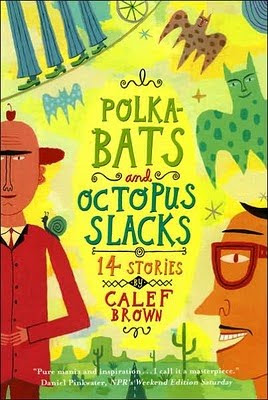

Calef Brown plunged into the world of kid's books with Polka-Bats and Octopus Slacks: 14 Stories, published in 1998, which my kids received as a gift that year, and what a great gift it was. Be sure to visit polkabats.com for more about Calef's great books for kids and fun stuff. Brown's colorfully crazy illustrations are perfectly paired with his poems, which have titles like "Kansas City Octopus," "The Bathtub Driver" and "Sleeping Fruit." Calef Brown's work is reminiscent of the work of the band They Might Be Giants, if they were poets, not musicians, and, of course, if they could illustrate their own work...
Brown has a way with an absurd rhyme and, as my father-in-law inscribed in the copy of Polka-Bats he gave to my kids, Brown's books will introduce you to the "fun and mystery of words!" In his book, Tippintown: A Guided Tour, Brown takes you through a town, in rhyming verse, of course! From the top of Tippinoggin Mountain to a ride in the triple-decker "triple canoe" to the rare and amazing "Assortment Tree" who's
Leaves and shoots
and flowers and fruits
are various sizes and shapes.
See the luscious artichokes
and mulitflavored grapes.
Tippintown is definitely worth the visit. As the author's note says, "Calef Brown began his career as a tour guide at an early age, when he discovered the simple joy of pointing things out."

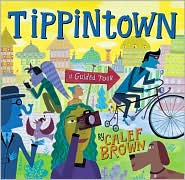
Here is a taste of Calef Brown's poetic sensibility...
Funky Snowman

Funky Snowman loves to dance.
You'd think he wouldn't have much chance
without two legs
or even pants
Does that stop Funky Snowman?
No!!
Turn up the music with the disco beat,
when you're in the groove, you don't need feet
Crowds come out and fill the street.
Kick it, Funky Snowman!
From Polka-Bats and Octopus Slacks
Calef Brown also collaborated with author John Harris, as well as many other authors, to create Greece! Rome! Monsters! and Pop-Up Aesop., which are definitely worth checking out, especially with the current craze for Greek Mythology that is going on.
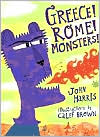
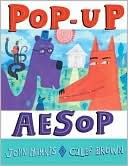
4.24.2012
Skeleton Flowers, poem and art by Calef Brown
4.23.2012
Fish, written by Gregory Mone, 241 pp, RL 4
I have to confess, Jake Parker's fantastic artwork for the cover of Fish by Gregory Mone caught my eye right away. Also, believe it or not, there are very few works of historical fiction featuring pirates that I have come across in my years as a children's bookseller. On top of that, at 241 pages Fish is perfect for high reading younger readers and reluctant older readers. But, best of all, Fish is fast paced, well written and filled with great (and wicked) characters!
Maurice Reidy begins his life during a raging flood on a not-so-properous farm in Ireland, one of nine children. One day, while bathing at the lake, one of Maurice's older brothers cruelly throws him out in to the depths of the water. Surprisingly, Maurice does not drown but instead experiences a burst of joy as his body finds its home in the water, thus earning Maurice the nickname "Fish." Although competent, Maurice is slow and disinterested in the farm work that he and all his siblings are required to do. That's why, when Shamrock the horse dies, he is sent to town to work for his Uncle Gerry and send money home to his family. Fish works as an errand boy for his uncle, running all over town. A very important task - the delivery of a purse of coins to a man about to board a ship - ends with Fish aboard the Scurvy Mistress. One of the best things about Fish is Fish himself. Although Mone begins his story swiftly, it is clear from the start that, even without his rare gift for swimming, Fish is cut form a different cloth. Knowing that his task is of the utmost importance to his uncle, Fish chases the thief, swims to and boards the ship he ran on to. A few chapters later, after he has been caught and forced to swab the decks for the pirates of the Scurvy Mistress, Fish steals back the purse form the captain's quarters and sneaks onto a ship that the pirates are raiding when he learns that the man he was supposed to deliver the purse to is on board. This kind of determination is admirable and believable, as thoughts of his horseless family back home are never far from Fish's mind. It is this determination, along with some help from his new friends, that makes the rest of the book so believable and enjoyable as well.
The educated, somewhat elegant Captain Cobb who, interestingly enough, has brought his wife Melida (women on any ship were thought to be bad luck) along with him, takes notice of Fish's determination (and swimming skills after Fish rescues a boy who is forced to walk the plank) right away. After convincing him to pledge his loyalty to him, Cobb sets Fish to swabbing the decks and cleaning the easement (a pirate ship's version of an outhouse...) With the help of Daniel, Nate - the thief who stole the purse from Fish and started the whole adventure - and with Nora, the young cook on board the Scurvy Mistress, Fish learns the ropes and then some. The pirate crew of the Scurvy Mistress are a fascinating lot, having divided themselves up based on their passions. There is Thimble, the pirate who loves wine almost as much as he loves sewing himself a wardrobe, Jumping Jack, the exercise leading pirate who just might have invented the calisthenic that bears his name and Sammy the Stomach, a skilled gunner who loves food so much he has named his cannons after his favorites (Mutton, Meat Pie, Sausage One, SausageTwo, and Zuchinni) and Simon, a pirate fond of word mash-ups. There are also pirates who congregate in groups that are fond of tea (the Tea Leaves), the Overs and Unders (ropes) the One Eyed Willies (self-explanatory) and the Scalawags for Sausage, of which Sammy the Stomach is the leader. When Scab, the quarrelsome second mate, takes a dislike to Fish and begins roughing him up at every chance, Daniel teaches Fish "not fighting," which involves learning to out and out maneuver your opponent. This fits well with Fish's character. He knows he can't win a physical battle with a grown pirate and he has no desire to use a cutlass or a pistol on anyone, so his tactical training is both essential and believable. I keep using the word "believable" in this review. Much like the difficulties a writer faces when trying to craft an authentic mystery with a child sleuth at the center, it is a challenge to write an adventure story filled with ruthless thieves and dangerous seas that can be navigated by a young hero. Mone does this swiftly and very well. While there were a few slippery plot spots near the climax of the story, every other step of the way I was right there with Fish, never doubting, never questioning.
The drama of the story comes when Fish learns that the purse he was to deliver is actually part of a chain of clues that might lead to the greatest treasure ever discovered. Captain Cobb, Melinda and their Oxford educated friend Moravius, whom Cobb insists pose as a silent giant in order to intimidate the crew, have spent the last ten years searching for the Chain of Chuacar, an enormous gold necklace that is rumored to be big enough to ring round an entire city. Scab and his men are not so sure this treasure exists and finished following the Captain as he chases after it. Throw a vicious treasure hunter and her timid son into the lot with the near mutinous crew and the real adventure begins. From start to finish, Mone does a superb job of keeping the plot moving, the description of life on board a ship as well as the interesting peccadillos and personalities of the pirates themselves brisk but vivid. Perhaps I have seen one too many a Jerry Bruckheimer pirate movie, but Mone's book was so visual and entertaining that I felt like I could see the fish darting in the clear blue water as I read. If you know someone who would like Robert Louis Stevenson's Treasure Island but isn't quite ready for a book that long, Fish is the book to grab! If you know someone who likes pirates and adventure, don't miss Fish! Although this is a story filled with fighting, cannons, pistols, cutlasses and plundering pirates, Mone keeps the violence to a minimum, instead devoting much time to Fish learning, practicing and enacting "not-fighting," which I greatly appreciated. From start to finish, Fish is a great book that I highly recommend. Thank you, Mr Mone, for filling an overlooked space on the shelves!
4.22.2012
The Tree that Time Built, selected by Mary Ann Hoberman and Linda Winston, illustrated by Barbara Fortin, 206 pp RL 3
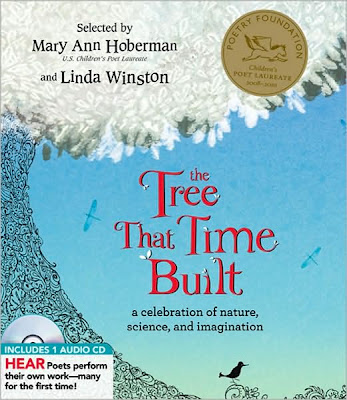
The Tree That Time Built: A Celebration of Nature, Science and Imagination selected by Mary Ann Hoberman, the current National Children's Poet Laureate and Linda Winston, a cultural anthropologist and teacher, has re-opened a door for me that I thought I had shut firmly. I was a child of the perfect age when Shel Silverstein's Where the Sidewalk Ends was first published in 1974. I still remember the day I was given that book and how I clasped it to my chest while alternately reading all the poems out loud to the nearest pair of ears. I bought A Light in the Attic when it was published in 1981 and gobbled it up. I even studied poetry in college and wrote my senior thesis on a book of poetry as well as writing my own poems. But, by the time I had started a family and found a career, I didn't have the time, energy or interest to keep reading poetry. although I made diligent efforts and purchases. I bought Falling Up in 1996 when my oldest was three, of course. Because I thought it was the right thing to do as an English Major and lapsed poet, I bought A Child's Anthology of Poetry edited by Elizabeth Hague Sword which is basically a child's version of a Norton Anthology of poetry, commonly used as a college textbook. The book contains poems written by adults that are appropriate for children and include luminaries such as Maya Angelou, Bashō, Elizabeth Bishop, William Blake, Lewis Carroll, ee cummings, Emily Dickinson, Rachel Field (author of one of my all-time favorite Newbery Winners, Hitty: Her First Hundre Years), FedericoGarcia Lorca, Thomas Hardy, Octavio Paz, Czeslaw Milosz, Li Po, Theodore Roethke,Walt Whitman, William Carlos Williams, William Wordsworth and William Butler Yeats, to name a few (too many, I'm sure.) Some poetry books (thankfully) were given to my children. Painter and poet Douglas Florian, creator of Dinothesaurus: Prehistoric Poems and Paintings, Mammalabilia, and Insectlopedia, among others not to be missed. But, however beautifully illustrated and magnificently written and/or compiled these books were, I (sadly) rarely opened and read from them for myself or my children. The Tree That Time Built: A Celebration of Nature, Science and Imagination changed that for me, and, I firmly believe that it was the accompanying CD that was the tipping point for me and my kids.



It probably goes without saying, but still bears repeating, POETRY SHOULD BE READ OUT LOUD - ESPECIALLY CHILDREN'S POETRY. Yes, poetry can be and is often meant to be a personally intense, private experience. But, so much of it is also meant to be shared with others, like any celebration. Before reading the poetry in the book, I brought the CD along on a car trip I took with my boys, ages 5 and 12, both of whom I assumed would at best, tune it out, at worst, demand to have it taken off. I was pleasantly surprised when, after turning it off to consult a map, my 12 year old asked me to put it back on. He is definitely a science minded sort, but not always a creative minded sort, so I was especially pleased when I learned not only was he listening, he was enjoying it! For a chance to listen to an interview with Hoberman and Winston, as well as hear a sampling of 10 poems from the CD, check out this story that aired on the radio program Here and Now with Robin Young. But really, just buy this book. If you only have two collections of poetry in your home, please make The Tree That Time Built: A Celebration of Nature, Science and Imagination the second one. The selection of contributing poets overlaps nicely with those in A Child's Anthology of Poetry and include Hans Christian Andersen, Wendell Berry, William Blake, Emily Dickinson, TS Eliot, Ralph Waldo Emmerson, Rachel Field, Douglas Florian, Robert Frost, Thomas Hardy, Langston Hughes, DH Lawrence, WS Merwin, Ogden Nash, Mary Oliver, Sylvia Plath, Rainer Maria Rilke, Theodore Roethke, Chirstina Rossetti, 1996 Nobel Winner Wislawa Szymborska, and Walt Whitman, naturally. Also contributing a poem and a reading is Ruth Padel, Charles Darwin's great-great granddaughter! Unlike A Child's Anthology of Poetry, there is an "About the Poets" section, a "Suggestions for Further Reading and Research" section and a glossary of the scientific terms at the end of The Tree That Time Built: A Celebration of Nature, Science and Imagination. There is also a superb introduction that explains the framework that brings together the selections in the book as well as a photograph of Darwin's "Tree of Life" diagram from his notebooks, inspiration for his Theory of Evolution. The book itself is divided into 9 sections with the titles, Oh, Fields of Wonder, The Sea is Our Mother, Prehistoric Praise, Think Like a Tree, Meditations of a Tortoise, Some Primal Termite, Everything that Lives Wants to Fly, I Am the Family Face and, finally, Hurt No Living Thing. In addition to all this, there are footnotes, of sorts, for many of the poems. Some notes pertain to the type of poem - haiku, extended metaphor, assonance, shape poem, found poem - and offer definitions as well as suggestions for young poets. Other notes pertain to scientific terms, such as camouflage, "deep time," adaptive functions and theory. All bold words that appear in the notes also appear in the glossary. Not only are we given the gift of hearing the poets reading their poems, we are offered instruction and gentle encouragement from a National Poet Laureate as we travel through the sometimes mysterious world of verse!
As a way to seal the deal, I leave you with a few short (but sweet!) poems from The Tree That Time Built: A Celebration of Nature, Science and Imagination.
"Metamorphosis"
Metamorphosis:
Caterpillar, chrysalis,
Butterfly is born.
Mary Ann Hoberman
*Hoberman's note to text* The type of poem known as a haiku calls for three lines of five, seven and five syllables. I was delighted when I discovered that the words that define and mark the stages of a butterfly's development slipped so perfectly - rhythmically, melodically, and visually - into the haiku form.
"The Pedigree of Honey"
The Pedigree of Honey
Does not concern the Bee-
A Clover, any time, to him,
Is Aristocracy-
Emily Dickinson
"Secretary Bird"
Take a letter:
Say that
the ancient trees are falling.
Say that
the whale's song grows faint.
Say the passenger pigeon is gone.
The great auk is gone.
The rhino, the mountain gorilla,
almost gone...
Dip your quill
in the sludge
along the river,
in the soot
from the smokestack,
in the poisoned lake,
in the burning rain.
Dip it in the blood of the great blue whale.
Take a letter, bird:
to whom it may
concern
Alice Schertle
*Hoberman's note to text* Unlike the Dodo, the Secretary Bird is still with us, although it, too is threatened by the loss of habitat and is a protected species in Sub-Saharan Africa. A large bird of prey, mostly terrestrial, its name probably comes from its feathered crest, resembling quill-pens tucked behind the ear, once the habit of secretaries. Playing with this coincidental name, the poet dictates a somber letter.
And, finally, The Tree That Time Built: A Celebration of Nature, Science and Imagination also nudged me into finally buying another book of children's poetry in which you can open to any page and find a read-out-loud gem...

The Llama Who Had No Pajama is Mary Ann Hoberman's collection of 100 of her favorite poems that she has written, illustrated by her long-time collaborator, Betty Fraser.
4.20.2012
Fake Mustache, written by Tom Angleberger and illustrated by Jen Wang, 196 pp, RL 3
Tom Angleberger has to be the greatest author to come along in a while when it comes to writing books for kids who just don't want to tackle the 400 page fantasy novels that have been so popular for the last decade or more. His books The Strange Case of the Origami Yoda and the sequel, Darth Paper Strikes Back are excellent alternatives to Diary of a Wimpy Kid for those of you who don't want your young readers to dip their toes into that pond. For those of you with kids already hooked on Jeff Kinney's series, Angleberger's books are perfect (although much better, in my humble opinion) for fans of the Wimpy Kid series. Then, there is Angleberger's fantastically funny Horton Halfpott OR The Fiendish Mystery of Smudgwick Manor OR The Loosening of M'Lady Luggertuck's Corset, a historical romp packed with characters with Dickensian names and Monty Python-esque proclivities and a mystery, too. Angleberger's books are all under 200 pages, sometimes silly, sometimes sweet and always out of the ordinary and always worth reading. His newest adventure, Fake Mustache, illustrated by the very talented Jen Wang definitely fits this bill! For more about Jen's (mostly adult) work, see the bottom of this review.
The very long subtitle (an Angleberger trait?) for Fake Mustache is as follows and sets up the story perfectly: How Jodie O'Rodeo and Her Wonder Horse (and Some Nerdy Kid) Saved the U.S. Presidential Election from a Mad Genius Criminal Mastermind. The book begins with our first narrator, Lenny Flem Jr, accompanying his best buddy, Casper Bengue to Sven's Fair Price store in downtown Hairsprinkle so that Casper can spend his birthday money. Casper's parents are hippie-types who don't believe in television or other unnecessary things, so his Nanna Nookums gives him money each year and instructs him to buy something completely unnecessary. This year, she sent him $400 to buy a PlayStation. Not having a television, Casper decides to buy the Heidelberg Handlebar Number Seven, a very expensive, handmade fake mustache and a man-about-town suit to go with it. Unbeknownst to Casper, the Heidelberg Handlebar Number Seven (which costs $129.99) happens to have been "woven from the hairs of a very bad man who gave up his mustache unwillingly." In fact, it was ripped from the face of a professional assassin, "famous in the European underworld for his perfect record of three hundred kills and his perfect mustache. Then he was betrayed by a beautiful woman and arrested. When he arrived at prison, the shaved his mustache."
Straight away, Lenny notices that something is up with Casper. Banks are being robbed, sometimes by strolling accordion players, librarians, children's party clowns or mimes and a shortish man-about-town with a handlebar mustache calling himself Fako Mustacho seems to be positioning himself for a run for president. Meanwhile, Lenny finds bags of loot in Casper's bedroom and Casper keeps texting Lenny to explain his absences from trick-or-treating, curling practice and the like. When Lenny phones in an anonymous tip about Casper, he becomes outcast number one, also known by all of Fako Mustacho's hench-people as Evil One. Lenny decides to disguise himself, go on the run and get to the bottom of this funny business. The only costume he can afford is a Jodie O'Rodeo outfit that includes a wig with pink pigtails, a cowgirl hat and pink and white cowgirl skirt and vest. In the brilliant chapter 6, the reader gets all the details on Jodie and her Jodie O'Rodeo Showdeo, which is watched avidly by Lenny's little sisters and with mild interest by Lenny himself. After all, Jodie is cute and she sure can yodel. Jodie is a preteen cowgirl queen and a four page excerpt from a script from the show makes her seem a heck of a lot like Hannah Montana. But, instead of a secret life as a pop star, Jodie is a yodeling rodeo star who often rides her horse, Soymilk, into the mall to stop thieves and prevent her boyfriend from buying an Orange Julius for some other girl. As fascinating as Fake Mustache is, if feel like it really takes off when, near the second half of the book, Lenny meets Jodie and the two join forces to defeat Fako since she seems to be the only other person who believes he's a kid and not a short power-monger.
Part II of Fake Mustache is narrated by Jodie and she is a smart thinking, fast acting gal who helps Lenny out of some pretty weird scrapes. The two end up trapped in the factory and warehouses of the Heidelberg Novelty Company. This means that an escape route through an obstacle course that includes a jump into a vat of fake snot, a ride in a box filled with confetti and the final destination of a storage room filled with "President Fako! T-shirts, sweatpants, hats and more. The climactic scene in the book involves Soymilk, an Ultra-Sticky-Stretchy-Grabber-Hand and a mad sort-of-Frenchman with a gun pointed at the new president, thanks to rigged voting machines, Fako. Angelberger packs this book with more weird names, strange objects and every day stuff than I can even begin to share here. Needless to say, this is a VERY fun book to read and one kids will probably even want to read twice!
Readers who enjoyed Fake Mustache should definitely check out Andrea Beaty and Dan Santat's wickedly funny Attack of the Fluffy Bunnies!
More about Jen Wang:
Koko Be Good by Jen Wang caught my eye as I was shelving in the graphic novel section a year or so ago. Aimed at teens and adults, her debut graphic novel (she has contributed volumes 1 and 2 of Kazu Kibuishi's excellent Flight graphic novel anthologies, which also exist in kid-friendly editions titled, Explorer) Koko Be Good is the story of the free-spirited, self-centered Koko who's encounter with Jon, a pretty reserved college graduate trying to tie up the loose ends of his life before he joins his girlfriend who is working in Peru, changes both their lives. Set in San Francisco, the scenery is immediately recognizable, especially if you are young, Koko Be Good is so rich with detail and plot that you feel like you've watched a movie or read a traditional novel by the time it's over. While I love kid's graphic novels, I have read a handful of adult books and am amazed and impressed every time. Koko Be Good was one of the first I read and it will always stick in my mind.


4.18.2012
The Poetry (and artwork) of Douglas Florian
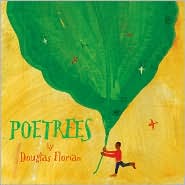
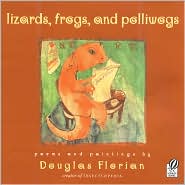
Douglas Florian has written and illustrated over 30 books of poetry for children. His poems are often playful, sometimes a little dark depending on the subject matter, and his artwork is always a bit dream-like and entrancing and very visually satisfying. Florian's artist's statement is a poem in itself, beginning, "My drawings are abstract regressionist. They are old but behave like little children." I think that is a wonderful place to start talking about his work...
Florian has chosen many different themes to dwell upon artistically, all of them very kid friendly. His books include poetic and playful titles like Laugh-eteria, Beast Feast, Insectlopedia, Dinothesaurus, Mammalabilia, Autumnblings, and are filled with short but succinct poems that perfectly conjure up the subjects they are exploring, like The Rhea, from Beast Feast.

The Rhea
The rhea rheally isn't strange -
It's just an ostrich, rhearranged.
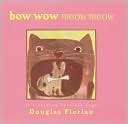
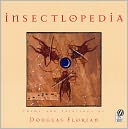
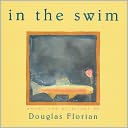
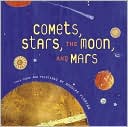
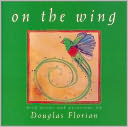
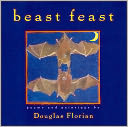
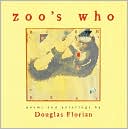
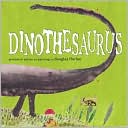
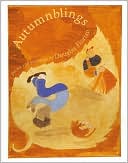
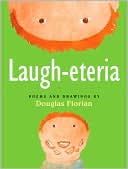
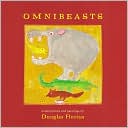
Many of Florian's books are available in paperback, including Laugh-eteria, Mamalabalia, Insectlopedia, On the Wing, Beast Feast, Bing, Bang Boing, In the Swim, and Monster Motel and are well worth the $7.00 or $8.00 cover price just for the artwork alone.
Also from Beast Feast, one of my favorite animals,
The Sloth
Up in a tree
The shaggy sloth
Is hanging by its claws.
It doesn't like to move at all.
It only likes to
p a u s e.
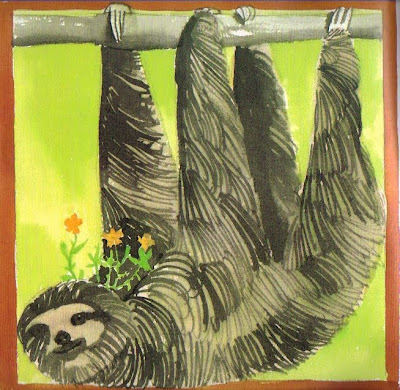
Subscribe to: Posts (Atom)
